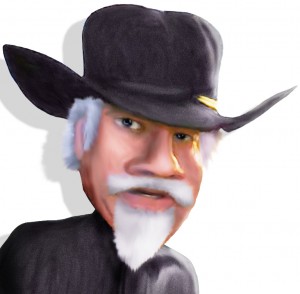July 30, 2019
Just Saying…
 By Q.C. Jones
By Q.C. Jones
Grandma’s Furnace, Chingachgook and Me
Recently, I shared recollections with my Texas Cousin about our grandmother’s house. As a child Cindy regularly spent a few weeks in the summer with my grandma in Central Illinois. With time, recollections fade and memories fuzzy. As weirdly strange as it may sound, she imagined the wrinkles in my cerebral membranes were granite solid and that I could turn back the clock a half-century or so with great ease.
It started with grandma’s address. I knew the street and I could easily drive to the century-old house she lived in. This one was easy because it’s a small town and every time I visit, I drive by for old time’s sake. I easily located the address using Google Street View. With Google help, I captured front and side pictures of the house. The old place looks pretty much
the same sans the millions of flowers grandma tenderly
maintained throughout her life.
Sending the photo of the house, helped us both recall the layout of her small two bedrooms with the old fashioned “Jack and Jill” bathroom accessible from both bedrooms. I imagined walking into the house through the back door; the front entrance was reserved for dignitaries like visiting preachers and the ladies coming over for one of her girl’s nights. It seems that practice saved the carpet and cut down on the need to vacuum the living room.
We took a mind’s eye tour of the kitchen, dining room, bedrooms and living room. When I suggested we tour the basement, Cindy stopped the conversation. To her, the basement was creepy. Her memories stopped at the basement stairs, yet to me the basement contained a pirate’s treasure chest of subconscious activity. Let me give you a quick tour.
At the top of the stairs, your olfactory receptors are met with the most unique scent in the universe. It was a delicate blend of drying flowers, musty earth and coal dust. I believe smell has the single most powerful ability to jar one’s memory. When I encounter just a tiny whiff of that distinct flavor, I become temporarily mesmerized. Neurons fire in strange ways, and I am carried back to 1962 and an eight-year-old version of me blazing down those rickety old stairs. I can plainly hear grandma giving me last-minute instructions on furnace operation.
My grandmother heated her house with coal. Looking back, most of the older houses in my little town were heated with coal. We were a coal mining community. My grandfather and his brothers were all coalminers.
Somewhere about 300 feet below the schools, streets and churches, the earth was honeycombed with tunnels dug through the earth to reach the shinny black minerals. Coal furnaces were as commonplace as electric toasters and shiny chrome coffee peculators. I, like many of my classmates, took over tending the furnace at the ripe age of eight.
A little background, every home had a coal chute. The remnants of these can still be observed in older neighborhoods of our QCA. They look like a basement window except they are made of strong solid steel. Some were plain, others simply said “coal” and a few bore the name of the manufacturer; names of long-defunct manufactures of a different age like Majestic Coal Chute 101. The chute was used to load coal into the basement of the house into what was called a coal room.
The coal room was adjacent to the furnace, and in my grandma’s house, the ceiling was lined with tin. The tin was there to protect the house, as much as possible, from the dust created when the coal came tumbling out of the dump truck which delivered the coal. These rooms were dark, dirty and the walls were completely stained by the oils found in the bituminous coals burnt. Now onto the real centerpiece of the operation.
Just outside the coal room lurked a giant asbestos, steel and masonry beast. It had a plethora of heavy cast steel doors each adorned with the name of the monster’s maker and arms which extended up into the bowels of the home. Standing next to the furnace was a “stoker” which was a device designed to allow for a more even flow of coal into the furnace.
It was my job to fill the stoker with coal upon each visit. This ranged from a few shovels full to something like a bushel of coal depending on the weather. All pretty low skill and easy. The next step was to remove the coal cinders, which were called clinkers. These were red-hot pieces of combusted coal mixed with the rock and trace minerals found in the coal.
Clinkers were hot and relatively dangerous to remove. A special grabbing tool was used to reach into the far recesses of the furnace for their removal. Once removed they were placed into a small bucket for cooling; cooling was an overnight process. The cooled cinders were placed in a much bigger tub and carried to the alley once a week. The city hauled them away for use in landfills, paving allies and other uses.
Getting back to my conversation with my cousin, Cindy. Being a girl and basement averse, she missed out on this little slice of history. Thinking about the whole process made me realize, I am akin to the last of the Mohicans. For nearly 200 years, coal was a primary source of heat in homes; everybody knew the process. Today, I could be the last of the last to recall the experience. Just like Chingachgook, I am the last of a dying breed. Just saying…
Filed Under: History
Trackback URL: https://www.50pluslife.com/2019/07/30/just-saying-46/trackback/


